Diocesan ministries continue serving despite COVID-19 and its aftereffects
By Bill Brewer
If hope opens doors, then Bishop Richard F. Stika is an optimistic — and joyful — spiritual doorman.
As the nation and the world continue to grapple with COVID-19 and its ghastly ripples, the risen Jesus is all the hope we need to see us through the pandemic, according to the shepherd of the Catholic Church in East Tennessee. The bishop has confidence in hope and is resolved that the world will emerge from isolation and quarantine with a fresh perspective on life — and faith.
And he believes the Church in East Tennessee is a testament to that faith, hope, and resolve. He only has to point to the parishes and people of the Diocese of Knoxville as examples.
When the federal government declared the coronavirus a national emergency in mid-March and then announced social-distancing guidelines to curb the spread of the highly contagious and sometimes deadly virus, state and local governments followed with safe-at-home orders for residents and mandates for schools and non-essential businesses to suspend operations. Churches were urged to comply.
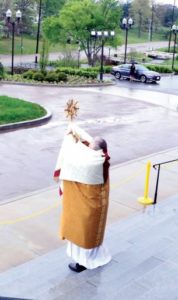 Heeding their advice, Bishop Stika and the bishops of most U.S. dioceses and archdioceses have temporarily closed their churches to the public while priests have continued celebrating Masses without congregations. Although public Masses and other Church-related services where more than 10 people are likely to congregate are on hold, the bishop has encouraged churches to keep their doors open to the faithful, offer adoration of the Blessed Sacrament, and hear confessions in sanitized confines.
Heeding their advice, Bishop Stika and the bishops of most U.S. dioceses and archdioceses have temporarily closed their churches to the public while priests have continued celebrating Masses without congregations. Although public Masses and other Church-related services where more than 10 people are likely to congregate are on hold, the bishop has encouraged churches to keep their doors open to the faithful, offer adoration of the Blessed Sacrament, and hear confessions in sanitized confines.
“We are Epiphany people, like we are reminded. We are Christmas people, but especially we have the risen Jesus,” Bishop Stika said following his celebration of Easter Mass. “I often think of how it must have been in those first years when they celebrated the resurrection under persecution. They had to hide in basements and the catacombs. And there was an awful lot of uncertainty there. And throughout all the ages with pestilence and plague and war. And yet the Church is still here today.
“So we’ll get through this. We are a hopeful people. Hope is one of those things that opens the doors for us in a variety of different ways. We have to trust in Jesus and His divine mercy. We’ll get through this. I still have my mantra: ‘The only thing to fear is fear itself, or the lack of common sense. It’s going to be OK.’”
Diocese of Knoxville priests have heard Bishop Stika’s call to find creative ways to reach their members during this unsettling time. And many have responded, turning to social media, other new media, and old-fashioned personal outreach to connect with members and keep them spiritually nourished. Other ministries have responded as well, braving the uncertain elements to be the face, hands, feet, and heart of Jesus.
Here are snapshots of the new, albeit temporary, normal for the Catholic Church in East Tennessee.
Learning to livestream
Faced with the dilemma of their churches closed to public gatherings larger than 10 people amid the need to celebrate regular Masses, several pastors opened their media toolboxes and took crash courses in video livestreaming.
 Among the churches that set up video cameras and live feeds to online platforms like YouTube and Facebook are the Cathedral of the Most Sacred Heart of Jesus, All Saints, the Basilica of Sts. Peter and Paul, Our Lady of Fatima, St. Albert the Great, St. Dominic, St. Francis of Assisi in Fairfield Glade, St. John Neumann, St. Jude, St. Mary in Johnson City, St. Michael the Archangel, St. Therese, St. Joseph, and St. Thérèse of Lisieux.
Among the churches that set up video cameras and live feeds to online platforms like YouTube and Facebook are the Cathedral of the Most Sacred Heart of Jesus, All Saints, the Basilica of Sts. Peter and Paul, Our Lady of Fatima, St. Albert the Great, St. Dominic, St. Francis of Assisi in Fairfield Glade, St. John Neumann, St. Jude, St. Mary in Johnson City, St. Michael the Archangel, St. Therese, St. Joseph, and St. Thérèse of Lisieux.
Father David Carter, rector of the basilica in Chattanooga, said instead of getting in-person feedback on liturgy and homilies following Mass, he now is getting “likes” and “follows” on social media.
“Obviously, the normal face-to-face interactions with parishioners at Mass and on Sundays have dropped precipitously. The regularly scheduled groups, book studies, Bible studies, homeschool co-op, and other parish offerings have ceased to meet in person during this time. However, this has caused us to be creative and much more proactive in reaching out to our parishioners,” Father Carter said.
“We have been able to reach out by modern means of technology and stay in touch with our parishioners. Our Masses are streamed live on our Facebook page. Our parish council, youth group, young couples ministry, and even a group praying the Liturgy of the Hours, have met via online services like Zoom. I have also taken an initiative to go out to the families with adoration of the Blessed Sacrament, keeping in mind the requirements of social distancing. I have arranged it so that families can adore our eucharistic Lord and receive a eucharistic blessing from their front porch as I come to them by car. We have increased our e-mail communication and the use of myParish app just to continually stay in touch with our people,” he added.
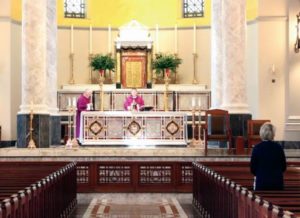 Father David Boettner, rector of the Cathedral of the Most Sacred Heart of Jesus, said the cathedral was outfitted with robotic cameras and additional camera inputs when it was built. And the cathedral has two men with broadcast backgrounds leading the livestream video productions: Sacred Heart communications director Steve Coy, and Diocese of Knoxville communications director Jim Wogan.
Father David Boettner, rector of the Cathedral of the Most Sacred Heart of Jesus, said the cathedral was outfitted with robotic cameras and additional camera inputs when it was built. And the cathedral has two men with broadcast backgrounds leading the livestream video productions: Sacred Heart communications director Steve Coy, and Diocese of Knoxville communications director Jim Wogan.
“The live streaming was awkward at first because I am an extrovert by nature and saying Mass to an empty church was difficult. The Cathedral parishioners, however, have been amazingly supportive. The first weekend that we livestreamed Masses, many of them sent me pictures of their family gathered around the screen worshiping together. That gave me the visual that I needed to help me say Mass while imagining the people present even though not physically. Many of our people have created home altars to help them place their selves in a worship environment. We are able to see how many households are watching the live stream and for example, on Palm Sunday weekend, we touched over 9,000 households,” Father Boettner said.
“The feedback we are getting from our parishioners has been very positive. Clearly everyone misses being together for worship and not receiving communion is painful to everyone, but it is the best possible alternative we have at this time while keeping everyone safe and healthy,” he added.
Father Boettner plans to continue the livestreaming of Masses once full Mass participation resumes. He said the cathedral Masses and devotions are reaching at least 20 different countries as well as many states. And they also reach elderly and homebound parishioners.
Jim Wogan, director of communications for the Diocese of Knoxville, said the number of online views to the diocesan website, which has links to the livestreamed Masses, has been up sharply since Masses were suspended in March.
Learning to school at home
Virtually on a dime, Diocese of Knoxville schools shifted from in-class learning to distance learning when classes were suspended because of the coronavirus. In just a few short days over spring break and just beyond, school administrators and faculty implemented a stay-at-home curriculum for all students.
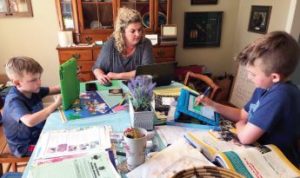 Once the hiatus was over, younger students were receiving packets from their teachers filled with schoolwork to keep them on pace to complete the school year. And middle and high school students began participating in classwork via home computers.
Once the hiatus was over, younger students were receiving packets from their teachers filled with schoolwork to keep them on pace to complete the school year. And middle and high school students began participating in classwork via home computers.
And as the diocese’s 10 schools were staying on track to finish the school year, many, if not most, East Tennessee public schools are remaining closed for the rest of the school year with no comprehensive program to complete their graded curriculum via distance learning.
“In a way, our Catholic schools have been preparing for such an occurrence for a while. Over the last several years, our schools have been systematically increasing the technology infrastructure, teacher expertise in various digital platforms, and adopting curriculum resources and materials that provided access digitally, as well as in standard hard copies, such as textbooks,” said Dr. Sedonna Prater, superintendent of diocesan schools.
“Our teachers and school leaders have been daring in their exploration of instructional methods and resources that could lend themselves to a digital environment, such as project- or problem-based learning that relies on inter-disciplinary approaches and a synthesis of different skills,” Dr. Prater noted. “In educational language, this one-to-one usage of technology is known as a ‘flipped classroom.’ Our instructional methods have never relied on just one method and, in spite of the fact that we had concerns about too much technology, our teachers learned these strategies in case we had extended closures due to weather or illness. So, for the last several years we have been exploring what ‘virtual school’ days could look like. However, I do not want to convey that we were completely ready to move to virtual days. As we began monitoring the spread of this illness in January, we discussed strategies, but each school took at least one day of professional development time to actually make the definitive plans.”
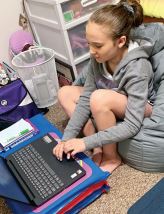 Dr. Prater said all of the newly adopted curriculum resources have some sort of digital platform, e-textbooks, and online assessment features. Some schools are using Moodle, some are using Google Classroom, while others are using Microsoft Teams. Schools also have been using Zoom video conferencing.
Dr. Prater said all of the newly adopted curriculum resources have some sort of digital platform, e-textbooks, and online assessment features. Some schools are using Moodle, some are using Google Classroom, while others are using Microsoft Teams. Schools also have been using Zoom video conferencing.
In the weeks since the coronavirus specter first appeared in January, diocesan teachers have spent time learning how to use these digital tools so they would be prepared to create engaging lesson experiences for their students.
“This did take a great deal of time, as teachers had to design their lessons and instruction in new ways while trying to increase their students’ prayer life and faith formation, as well as promote community, continuity, and consistency,” Dr. Prater said.
She said all students are equipped with some sort of digital device. And for students who did not have access to a computer or the Internet, school leaders provided those resources for families. And she noted that teachers and students have responded in very positive ways to successfully continue learning.
As a result, Diocese of Knoxville students will remain on course academically as they begin the new school year in August.
Dickie Sompayrac, president of Knoxville Catholic High School, said KCHS was able to pivot from in-class learning to distance learning so quickly because the school’s faculty has been making the transition for years.
“Four years ago, we moved to 1-to-1, which really means two things: all students had a laptop and the school started using Moodle as our online learning management system. Teachers can post lessons, videos, and PowerPoints, in addition to giving quizzes, tests, and other assessments through Moodle. So in essence we have been making this transition over the last four years, which has enabled us to really be ready for this pandemic from a teaching and learning standpoint,” Mr. Sompayrac said.
 He noted that KCHS administrators and faculty began discussions in early February on the possibility of a lengthy school closure. A day of in-service training was held March 13, just days before the shift from in-class instruction to distance learning.
He noted that KCHS administrators and faculty began discussions in early February on the possibility of a lengthy school closure. A day of in-service training was held March 13, just days before the shift from in-class instruction to distance learning.
“Our teachers, I believe, felt prepared for this when it began on March 25. I think one of the unintended positive outcomes of this will be a re-examination of courses that we may be able to offer online as a result of this shift to at-home learning,” said Mr. Sompayrac, who added that the transition has gone very smoothly for faculty and students.
Father Boettner said distance learning at Sacred Heart Cathedral School has been going well as teachers and students adapt to the change.
“Our distance learning has been an adventure and our teachers, parents and students have done an amazing job adapting to the new model. Our teachers are working twice as hard as with an in-person environment. We have used the phrase “We are building the boat while trying to sail it.” It is not easy, but every day we are getting better at it. I had the opportunity to teach the Mass to second grade through Zoom, and I am meeting with my middle-school mentor group through Zoom. At first I was intimidated, but now I am enjoying having the interaction with our students and they are continuing their learning. It was such a joy to see their faces and have the opportunity to talk with them,” he said.
Andy Zengel, principal of St. Joseph School, is thankful so much time has been spent by diocesan educators on learning to use digital platforms. And he is bolstered by the quick response of teachers and students to the recent shift in learning models.
“As with any group, there are some teachers who are more confident in using new technology than others. I’ve been very impressed with how our staff has grown in this area in a short time and how they are helping each other produce high-quality lessons for our students. We have teachers sending out daily videos, hosting Zoom sessions, creating YouTube pages, launching virtual tutoring sessions, etc. They are going above and beyond to reach every family and continue the teaching and learning for St. Joseph students,” Mr. Zengel said.
“Our students have been familiar with using Chromebooks and the Google education apps. They quickly got on board with Google Classroom as our primary platform. I get to see photos from parents of their children working from home, pictures of projects, Zoom sessions with smiling faces, etc.,” he added. “I am privileged to teach eighth-grade religion at St. Joseph, and my students are tackling this challenge with skill and hard work. I’m very proud of them. It’s clear that our kids miss their teachers, their classmates, and the culture of being at our school. Teachers are doing everything they can to provide time for classmates to see each other online and interact, but it just can’t be duplicated online. We miss them, too.”
For Sister Marie Blanchette, OP, principal of St. Mary School in Oak Ridge, the faculty and school families adopted a “drive-thru” approach to distributing resources for the home. It was the student drop-off process in reverse.
“The teachers have been absolutely phenomenal. Every one of us has been stretched by this experience. We have had to change the format of teaching. We use technology to teach, but in a very different way than for remote learning. We had several different lessons on various platforms teachers could use to deliver instruction,” Sister Marie Blanchette said, describing how she and other Dominican Sisters at the school, along with a school family, worked over spring break to implement the shift to distance learning. Chromebooks were available to families who wanted to borrow one.
Then on March 23 and March 24, parents were instructed to pick up their at-home education resources.
“With everything in place, we began ‘drive-thru’ service. We had communicated with our families the times the parents could come on March 23 and 24 to pick up the items. I was standing at the main entrance where parents drop off their children each morning. I used a walkie-talkie to let the staff inside know which family was here, and then they would bring everything to their car. I didn’t realize how much it meant to me to see so many parents and some of the children while they were getting their items. I guess not knowing when I would see them again made the moment more poignant,” Sister Marie Blanchette said.
“Wednesday, March 25, was the first day of learning at home and the beginning of the period of adjustment. There were initial issues with some of the Chromebooks, and some families with several young children were overwhelmed because each child needed some individual attention from a parent. The parents and the students had to adjust to this new way of learning. We sent out a survey after three days of learning at home and then adjusted what we were doing based on the results of the survey,” she added.
The Dominican Sister said she and the St. Mary faculty have been very attentive to the emotional needs of the St. Mary families.
“We made a video of the almost-empty school, showing how the sisters have taken over the recycling program at school; how Herbert the snake shed her skin; how much Myrtle the turtle misses the students; and we even had Miss Susie, who keeps our school shining and beautiful, say a few words to the students about how much she misses them. We recorded Father (Brent) Shelton in an empty classroom singing his favorite original song, ‘St. Mary’s School,’ for the students,” she said. “We also gave each employee one word that was part of a message to the school. The employee wrote and decorated the word and then sent a picture of him/herself holding the sign to the school. Our assistant principal put the pictures together and we e-mailed the message home to our families. The responses from the parents were great!”
St. Joseph followed a similar path, with faculty members distributing learning packets to parents using a “drive-thru” method in front of the school. And Mr. Zengel was recorded in a creative video showing him and the empty school longing for students to return.
The educators agree that while distance learning has been a blessing amid the upheaval, the classroom is where real growth — academic, spiritual, social, and emotional — occurs for students, and they look forward to their schools being full of kids again.
Still helping those in need
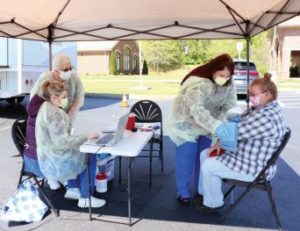 Like Diocese of Knoxville schools, Catholic Charities of East Tennessee and the St. Mary’s Legacy Clinic realize their ministries must continue despite federal, state, and local calls for as many organizations as possible to curb operations.
Like Diocese of Knoxville schools, Catholic Charities of East Tennessee and the St. Mary’s Legacy Clinic realize their ministries must continue despite federal, state, and local calls for as many organizations as possible to curb operations.
And like the schools, Catholic Charities and the mobile clinic have had to adopt new methods to keep their staff, clients, and patients safe.
Sister Mariana Koonce, RSM, the physician who serves as medical director for the St. Mary’s Legacy Clinic, said suspending clinic operations was never a consideration because the clinic’s patients in rural areas of the diocese are sustained by the clinic’s medical care. The clinic’s patients are either uninsured or underinsured.
And many of the clinic’s patients are individuals with health conditions that make them “vulnerable” to the coronavirus under CDC guidelines, such as high blood pressure, diabetes, and respiratory conditions.
“We cannot completely cease operations because our patients depend on us. We have modified how we care for them, however, in order to mitigate risks. Because we have been operating for six years and know many of our patients well over the course of time, we have been able to adopt some remote management protocols to continue to care for them without seeing them in person,” Sister Mariana said.
“One of the challenges we have faced is how to continue ensuring our patients are able to receive the medications they need to control their chronic diseases. Many rely on us to give them their basic blood pressure and diabetes medications. While some can afford to go to a pharmacy and pick it up if we call it in, others cannot. Other medications are just too expensive for anyone to buy. So maintaining our patient’s access to routine medications is a high priority for us,” she added.
That doesn’t mean the clinic has not adjusted operations because of the coronavirus. Sister Mariana said the clinic relies on volunteers to operate, and most of them have been instructed to stay home because they are considered high risk if they catch the virus due to age or health conditions. Clinic hours and site visits have been scaled back, too. She is relying on phone calls to communicate with patients when appropriate. True telehealth visits with patients, where the doctor and patient can visit one-on-one via Internet video connection, isn’t an option for many patients because they don’t have access to the Internet.
When the clinic is seeing some patients, the doctor and her staff are wearing masks, gloves, and gowns. She said some patients are scared of contracting the virus, while others aren’t. And where appropriate, clinic staff is delivering medication to patients. Sister Mariana said the clinic has temporarily stopped taking new patients until the crisis ends.
None of her patients that she knows of has had COVID-19, and she isn’t surprised by that since most of them live in rural, isolated areas where the virus is less likely to spread.
“While their medical situation may put them at high risk, I really did not expect that our patients would be likely to pick up the virus casually. This is one reason why we have been careful to scale back our clinic visits. We did not want to unintentionally expose our patients to the virus brought in by us. It works both ways. We need to protect ourselves from getting the virus from our patients and protect our patients from getting the virus because they came to the clinic,” she said.
Dr. Brandy Fuesting, executive director of the clinic, who is a specialist in public health, said the timing of the coronavirus outbreak is unexpected. But she is prepared to help lead the clinic and its patients through this national emergency.
“I have studied public health for many years. As a public-health practitioner, I have always known a pandemic of this nature was very possible, but I honestly did not think it would happen in my first year of running St. Mary’s Legacy Clinic. The great thing about public health is that we are always thinking ahead. It is our job to focus on protecting and improving the overall health of people and communities. It is because of my continued education that I have learned to think ahead in order to prevent, prepare for, and respond to a variety of situations such as a pandemic of this nature,” Dr. Fuesting said. “I was blessed to have been mentored by a diverse group of public-health practitioners. They have given me a multitude of tools that I have and will continue to apply to St. Mary’s Legacy Clinic’s operations.”
Sister Mariana said she is proud of her brother and sister physicians who are on the front lines of this pandemic applying their knowledge and skill to treat infected patients. It reminds her of “our ancestors in medicine” who had to treat patients with highly contagious Spanish flu, cholera, yellow fever, and smallpox.
“As a sister-physician, my role right now is to care for my existing patients. The uninsured are largely a forgotten component of this crisis, though I saw that the governor recently mentioned them in his briefing. Diabetes, hypertension, and chronic disease do not stop just because a pandemic is underway. Plus, these diseases place our patients at high risk should they contract COVID-19. So I want to keep my existing patients in the best health possible,” she said. “Hopefully, East Tennessee does not get into an overflow situation as other parts of the country have seen. If we do, I have the support of my religious community (Religious Sisters of Mercy of Alma, Mich.) to serve in whatever way is needed.”
 As Catholic Charities’ staff talked through the challenges posed by COVID-19, they were able to solve most of the coronavirus-based questions, and operations are continuing.
As Catholic Charities’ staff talked through the challenges posed by COVID-19, they were able to solve most of the coronavirus-based questions, and operations are continuing.
“All services are operating in all our programs. In some cases, we had to pause because the alternative to face-to-face client interaction was not as obvious, and we had to figure out how to serve the communities through our programs and keep the staff and clients safe. Counseling is more obvious with telehealth. It was less obvious how to serve in our pregnancy help centers’ education earn-while-you-learn program without being face to face,” said Lisa Healy, executive director of Catholic Charities of East Tennessee.
Catholic Charities’ ministry extends far beyond the offices of its headquarters near downtown Knoxville. Its services are needed in the urban centers of Chattanooga, the Tri-Cities, and Knoxville, as well as the outlying areas where pregnancy help centers, food pantries, and family-resource centers are located.
Other Catholic Charities services include Children’s Emergency Shelter, Samaritan Place, and community-supportive housing like Horizon Houses I and II, 5 Rivers, and Home Place, as well as mental-health counseling.
Times of crisis are just when Catholic Charities services are needed most by its clients of all ages, so closing during the COVID-19 emergency has never really been an option. Catholic Charities is serving those clients using guidelines issued by the Centers for Disease Control and Prevention.
“We never wanted to consider the option of not serving our communities. For us, it was figuring out how we keep our programs open serving clients who need us. How do we support those who need us now more than ever? For example, we had to figure out how to get food into the food pantry and food boxes out to clients at Newcomb Crazy Quilt Food Pantry and Family Resource Center. We closed for one week while we put processes in place, including getting the staff there to help get the food out. Now, clients call us by phone and ask for what they need. We have them stay in the car outside the pantry as opposed to walking in. We set the food outside the door, the client gets out of the car and picks it up. This takes more coordination and a couple more people, but it works and we are open and providing emergency food to this community,” Mrs. Healy said.
Mrs. Healy said Catholic Charities is now helping individuals and families that a month or two ago did not need help. With the economy virtually shutting down, many people now suddenly find themselves unemployed or underemployed.
And like nearly every other organization affected by the coronavirus outbreak, Catholic Charities is leaning heavily on technology to reach clients in a safe way. In addition to telehealth, Zoom and Microsoft Teams also have become indispensable to operations.
Mrs. Healy wants everyone in all communities in the Diocese of Knoxville to know that Catholic Charities is available to assist them if they need help in this time of national emergency.
“Life has changed for all of us, not just for the most vulnerable in our communities. The pandemic does not discriminate. You could be quarantined and can’t leave home; you may now be navigating how to keep your students learning although you never thought you would be a teacher; you may be anxious about how to make ends meet because of loss of hours or loss of your job; you may be grieving for one you may lose or have lost due to this senseless enemy,” Mrs. Healy said. “The disruption in our lives and in our community is frightening and overwhelming. Catholic Charities is here for you. Please call us. You are not alone. The pandemic will not last forever. Hang in there. Our communities will reopen and we will have survived this together.”

